 |
|
| You are here: Index > Surveys of Secondary Worlds > Alice | |
Reviewing American McGee's Alice games[written 01-06-2025]The last months of 2024 were a rollercoaster of mental states. I went through a tragedy, a job application was finally accepted, and my local church went through some rebranding. Because of this, my time for hobbies during that period decreased, and I felt that adult busyness that comes with new challenges and responsibility. Despite this I did manage to sink some hours into a couple games that allowed me to escape my agitated mind and placed me, ironically, in another person's violent mindscape. Personal Scorethis criteria uses the DecentFilms rating formula.Letter-Grade Recommendability: A+ 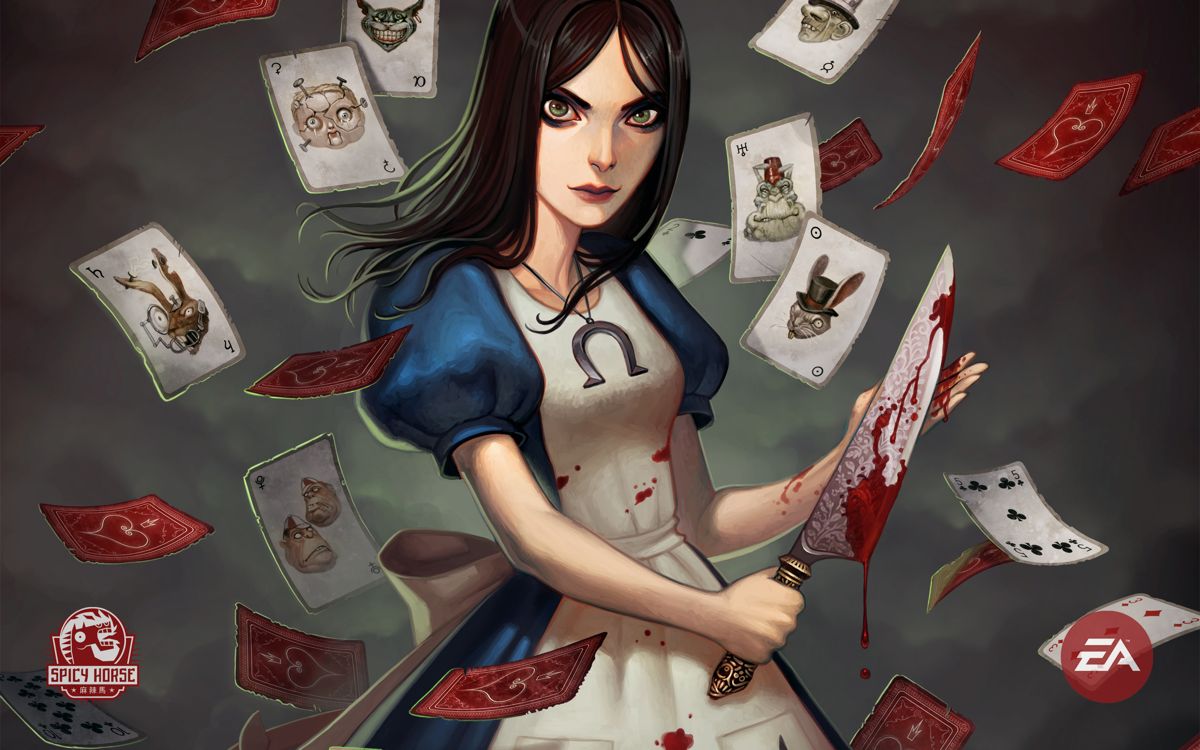
For background, American McGee was a level designer for arena shooter Quake 2 before creating a new game with its engine in the year 2000. Titled American McGee's Alice, it was a spiritual successor to the books with a dark future and a twisted Wonderland to explore. He then made a sequel to that game in 2011, Alice: Madness Returns, this time in the Unreal Engine and with a greater emphasis on platforming than its shooter-focused precursor. Until recently he had plans for a third entry, Alice: Asylum, but he had the misfortune of EA owning the rights, and they turned down the game and refused to sell the franchise. He's given up on the project now, disheartened, but has the luxury of a community of fans; his games on this dark Alice have become cult classics, and even after EA turned down Asylum there is still a good deal of material made by people who adore this grim series. I played through both games as well as read the design bible for Alice: Asylum, and I'll cover all three here and what I think about them. 
American McGee's Alice, the first title, starts us off with Alice Liddell surviving a housefire and losing her family. Stricken with grief and survivor's guilt, Alice's mind breaks, and she is put in an asylum. This is where we enter Wonderland: the world has become twisted by her trauma, and a wicked Red Queen reigns brutally over the inhabitants. It's up to Alice to confront the Red Queen and her cronies along the way, utilizing a collection of children's toys as an arsenal of arena-style weaponry. I like Alice's gameplay a lot. Its low graphical fidelity brings out its strong art design and I found combat very satisfying to navigate. The platforming was okay, with an awkward clamber animation that often halted pace, but the game has the good sense to include a jump marker so you don't overstep. It's clear however that this game's focus is not on platforming, but on combat, and the game philosophy of Quake can be seen here. The weapons are all incredibly unique - ice staff, ally-summoning dice, ball and jacks, and many others - and each have an alternate firing mode for plenty of utility. The worst of the weapons is the Vorpal Blade, which has a slow attack animation and a cooldown when thrown. You do start with it, though, and you collect the other weapons as you go along to challenge the wide variety of enemies and bosses. The combat felt very good and while many of the bosses were difficult I didn't feel like I was at a loss at what to do; with the exception of the Voracious Centipede, that is. The story and art take center stage, however. In true Wonderland fashion you and Alice travel through a purview of levels of varying kinds, from winding reviews to ant-hills to great green labyrinths. Of course this isn't the colorful and whimsical Wonderland we know, though its roots can still be seen, which makes the destructive warping of its landscape all the more poignant. Its characters take on many of Alice's feelings and thoughts, the bosses encapsulating and often blatantly referencing the traumas she has faced in her waking reality. This path of self-destruction threatens to doom this world, and if Alice wants to save it she needs to take control again. This isn't a complex story, none of Alice is, but the execution of it is very good. The voice acting is some of my favorites and works great with each character, with particular highlights from Alice, Cheshire Cat, and Jabberwock. The soundtrack is an excellent mix of music boxes and grimy synth that is pure earcandy - I've had "Battle with the Red Queen" pop into my head randomly from the moment I heard it. This all culiminates in an excellent game that I thoroughly enjoyed playing. I intentionally played these games in chronological order, however in order to play both I did buy Alice: Madness Returns - I actually bought two copies, one for PC and another for my Xbox 360, which I intend to use for a second playthrough. A remastered version of American McGee's Alice is available on both, though for the port on Steam you will need to apply a few tweaks to the game's settings and files. I do have a bit of experience with computers, but the Steam guide I followed was quick and easy; not only that, but I had a smooth playthrough on Linux through Proton (with the exception of a singular spot in Madness Returns). That being said, I completed Alice through the menu of Madness Returns, and once I was finished with its predecessor I then moved on to its sequel. 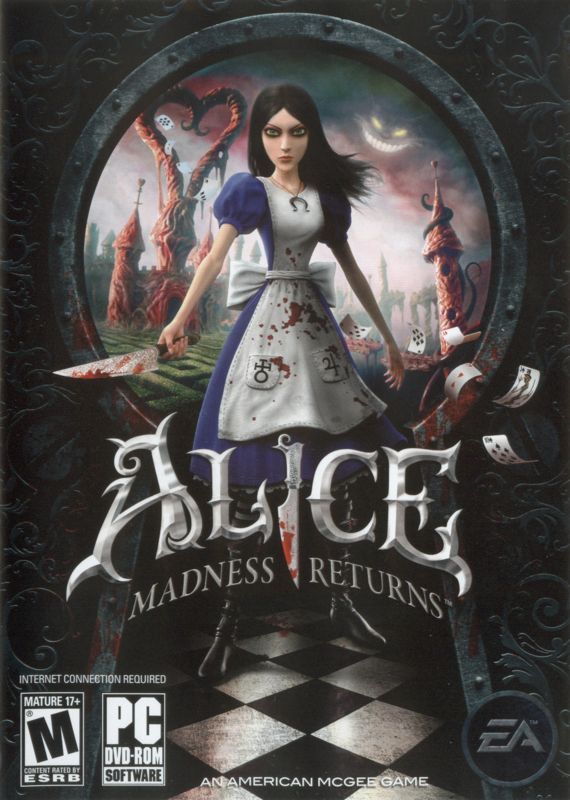
I actually didn't like this one as much. Or did I? It's actually a little complex. I love Madness Returns. In terms of its graphics and art style it directly challenges and even outdoes Alice for me. The Unreal engine is not wasted here: Alice's hair blows in the wind, and physics and effects reinforce the practicality of the world. This game is far more vibrant as well, with a wide array of textures and colors that really feel like a tapestry of sorts. It reinforces the themes of the game: Alice's condition has improved since the last entry, but her mind is still in danger. The platforming is far better than it was previous. Alice can double-jump and float, shrink to see hidden paths and passages, and dashes in a cloud of petals. The levels account for these new abilities, and so platforming is now a fundamental. Which is good, because it feels so good in this game. The combat, on the other hand, has been nerfed. There's fewer weapons here, though they are easier to select, and rather than alternate firing modes some weapons have new utilties related to unlocking paths. The game also has a lock-on mechanic that forces you into this Dark-Souls perspective, which I found quite awkward and often avoided doing except to fire projectiles. The weapons are still rather unique once again, though personally I find them less so - pepper grinder, clockwork rabbit, teapot, and umbrella. Referencing the wiki there were several other weapons that were cut in development, which is a darn shane. I will say that I did enjoy the Vorpal Blade this time around as well as the Hobby Horse; melee was much more enjoyable in this game than the last. The soundtrack was not as good this time around. It's good, but the first game's soundtrack is just so much better it's not even close. As I write this I have the faintest notion of several of the scores, particularly "Card Castles in the Sky". The change of composer is likely the reason: this tracks here are composed by Jason Tai and Marshall Crutcher, whereas Chris Vrenna of Nine Inch Nails fame composed the entire score of the first game. He did do one song in Madness Returns, "Wasteland", which as I relisten to it is very in line with the mood of the original game. It probably helps it was for the darker, steampunk stage in the game. Speaking of the stages, they're a lot more memorable in Madness Returns. While I don't think there was anything wrong with Alice's levels, Madness Returns has far more range. Underwater cities, oriental mountains, and floating card cities are among the many visual themes the levels embody in some form. Alice herself also visibly changes through the game, new locations and environments giving her a new outfit to match. I am a huge fan of Alice's dresses in this game, each taking her iconic look and adapting it to new aesthetics: steampunk, mermaid, royalty, and patchwork to name a few. They also have different effects in-game, such as limiting health or increasing drops from breakable objects, though I never noticed these changes in-game. There are also some DLC dresses - unlockable by cheating lol - that add new looks and effects. What these did was not only make each place fresh, but it cemented their aesthetic on the player as Alice goes on this quest for answers. On that note, let's talk story. Alice is out of the asylum, yes, but she's still troubled by a fractured Wonderland and still some lingering survivor's guilt. She lives in an orphanage overseen by a psychologist, who she and the other children speak to about their tragedies and traumas. Eventually there's that familiar white rabbit again, and off Alice goes to confront what remains plaguing her Wonderland, now known only as "The Train". Characters new and old make their appearance, the aftermath of the Red Queen's defeat is explored, and The Train now seems to be even greater a threat than the Red Queen ever was. The story here is a lot more interactive than it was before. We get sequences in Victorian England, far more limiting than Wonderland but a glimpse into what might be affecting the world within. Some major cutscenes are not real-time, but instead take the form of vignettes like a fairy-tale book. There are also some doors within levels, fiery in appearance, that allow Alice to look back into her past and reprocess the traumatic night of her family's death, allowing her to face the truth and process it. These are all done quite well, especially with the help of the terrific voice cast. Again this is done even better than the original, especially by Susie Brann as Alice, who really gives an excellent performance. Other notable voices are from Mad Hatter, Dormouse, and the Red Queen. I still liked Cheshire Cat, his voice was as good as ever, but I personally felt he was more forced than he was in Alice - in the original he would pop up unprompted and from anywhere around you, whereas here his convoluted oneliners arrive at the prompt of a button and a forceful turn of the camera. But that's only a nitpick, the story is great and on par with the original. What brings it down, however, is the lack of boss fights. In the original there are several bosses, from Duchess to Mad Hatter to the Jabberwock; here there is only one boss. It does make sense narratively for there to be a host of minibosses and a climactic final boss, but from a gameplay perspective I would have preferred shorter levels and a boss fight over what was made. But again it makes complete sense in the story, which I won't reveal here. In conclusion, I really like both of these games, and now that I put this into words I don't think I like one more than the other. They both fill each other's weaknesses and have strengths of their own to enjoy, and as a narrative and game series it deserves the hours I put into the game. As of the time of this review the combined time spent equated to 31 hours and was my second most-played game of 2024, which says something about my free time. 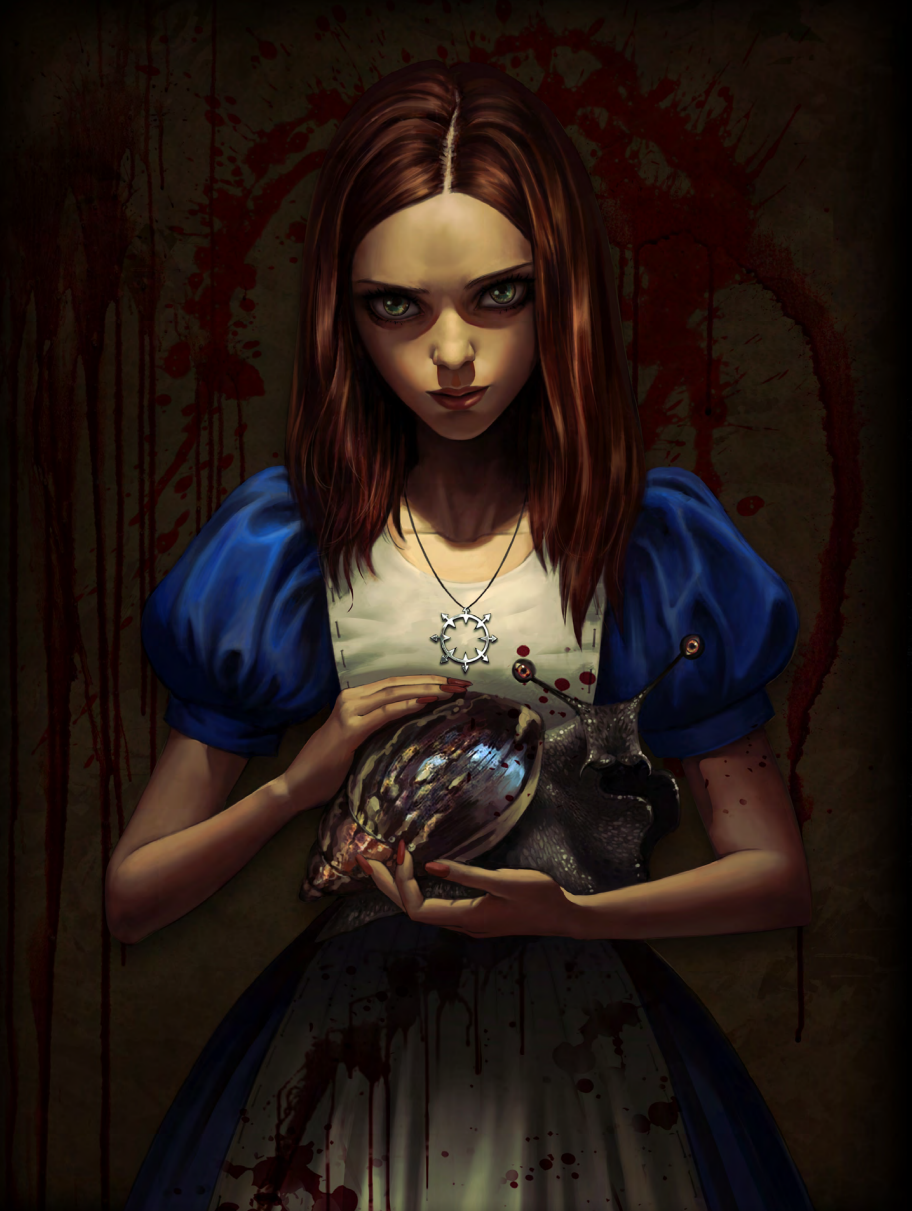
Now I didn't cover Alice: Asylum, so I'll do that here. Obviously it is a design bible, so a lot of the ground here is notes for gameplay concepts. Knowing what would have made it into the final cut or not is impossible, but there are a lot of good mechanics I was pleased to see, such as a return to alternate weapon modes. The story itself is a prequel to the previous two, following directly after Alice's trauma and while she is still in the deepest of her grief. There's a distinct emphasis on the horror this time, moreso than before, and stealth is noted as an option for some encounters, which does makes sense in story but I don't know if I would have liked it since stealth tends to be on the weaker side in modern game design. There's something to be said about American McGee's vision when even the design bible has outstanding art design. What's nice here is that the art is not bound by graphical limitations - though McGee intended it to use the Unreal 5 engine - and so the concept art is simply stunning. Strong uses of blood red and fiery orange are most common, and both stages and enemies are stunningly detailed. The story is woven in and takes up most of the book, and we can see how it would play out, with Alice specifically tackling the stages of grief. There are bosses here, some far scarier than we've seen before, and of quite a variety. This was an incredibly ambitious project, and I'm glad there's at least this to show for it. 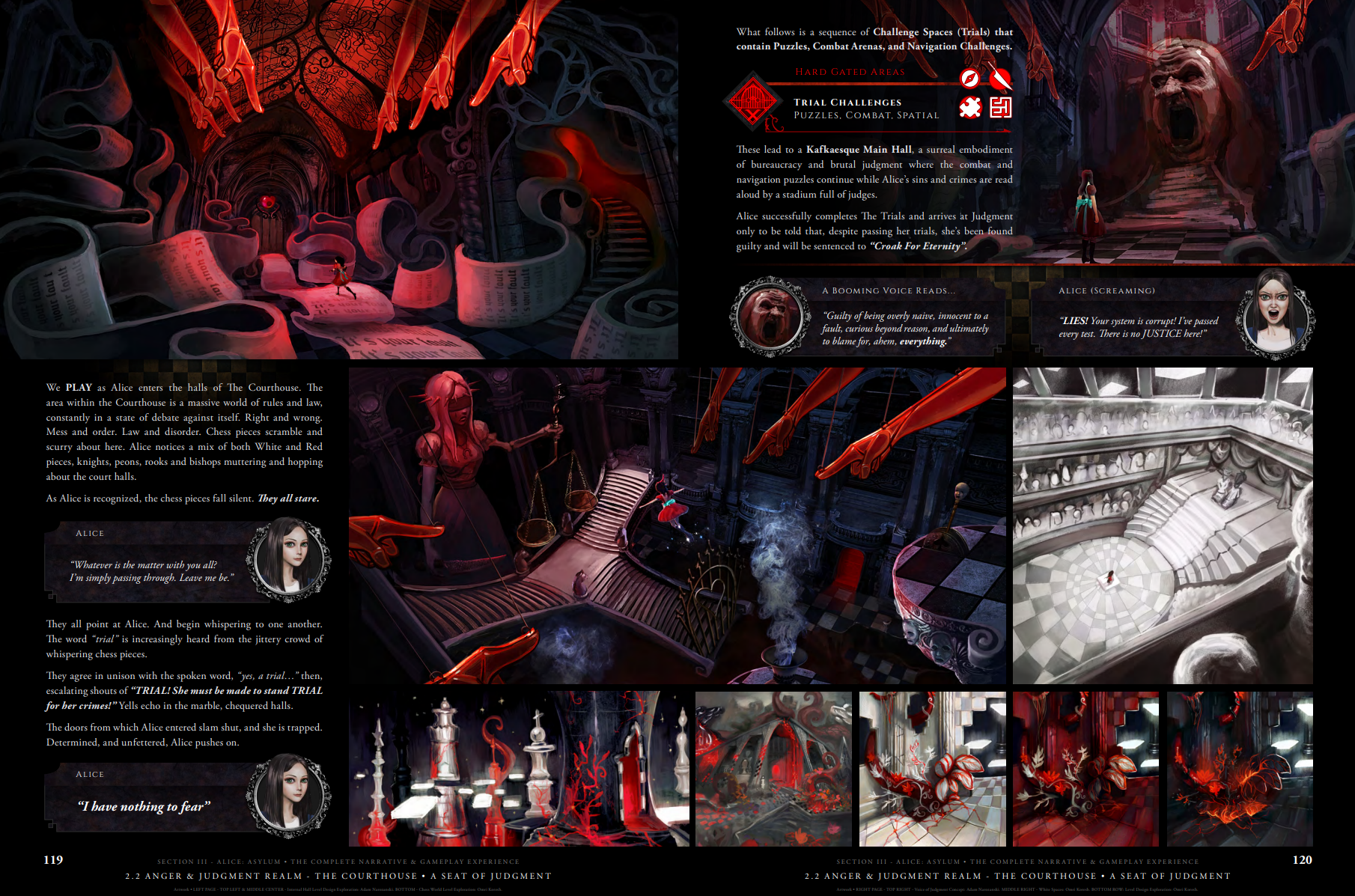
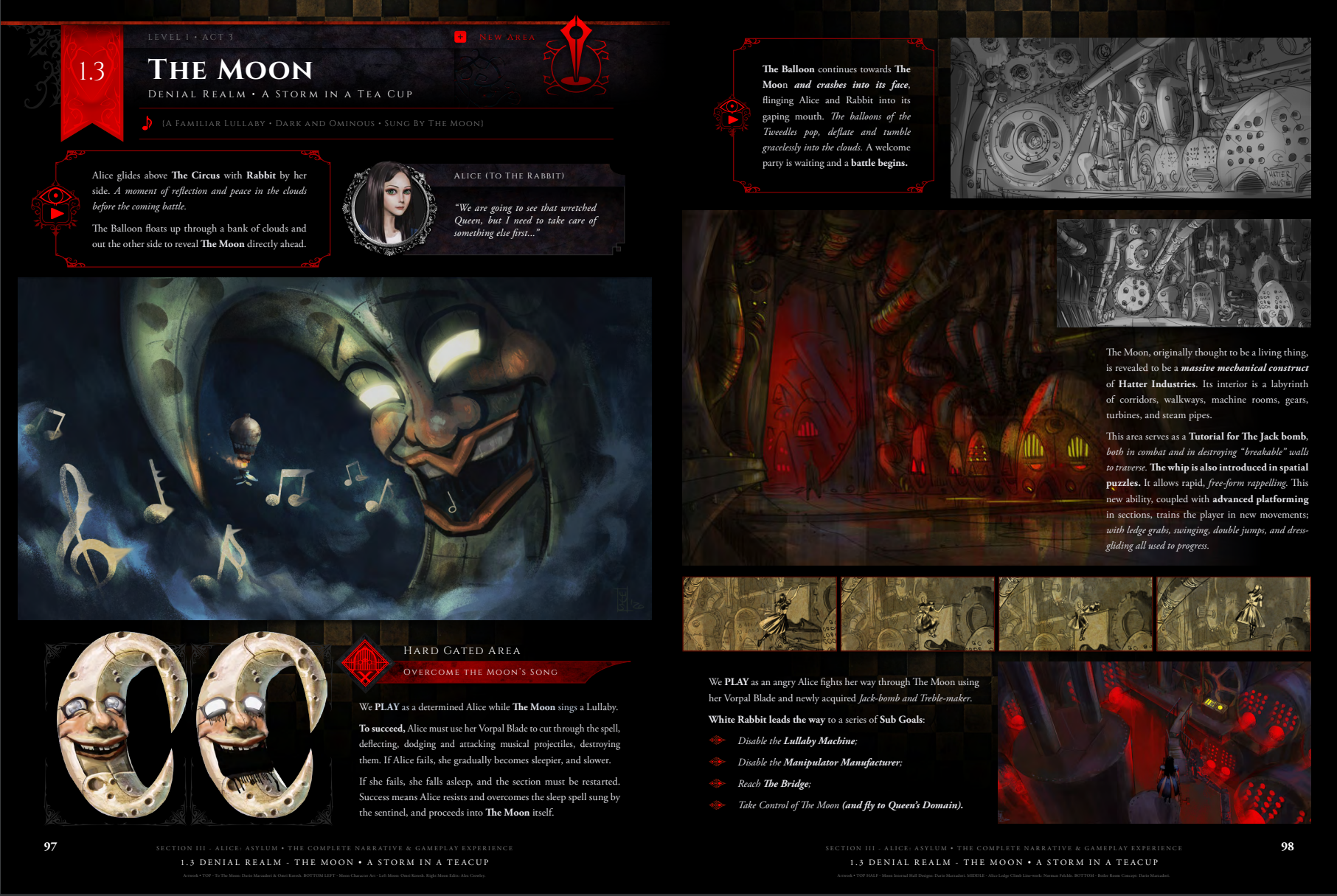
(click on the pages to see the full spread) American McGee has stated that he has given up on making more Alice, even if EA suddenly becomes interested again. I have heard rumor than the games that do exist may be getting an adaptation in the world of cinema, and while I do hope McGee is present for that I do not have any hope at the prospect of a Hollywood production of this Wonderland. Still, these two games do exist, and I highly recommend them and may even consider them one of my favorite series of all time. |
|
Exodite.org | 2023-2024





|
|